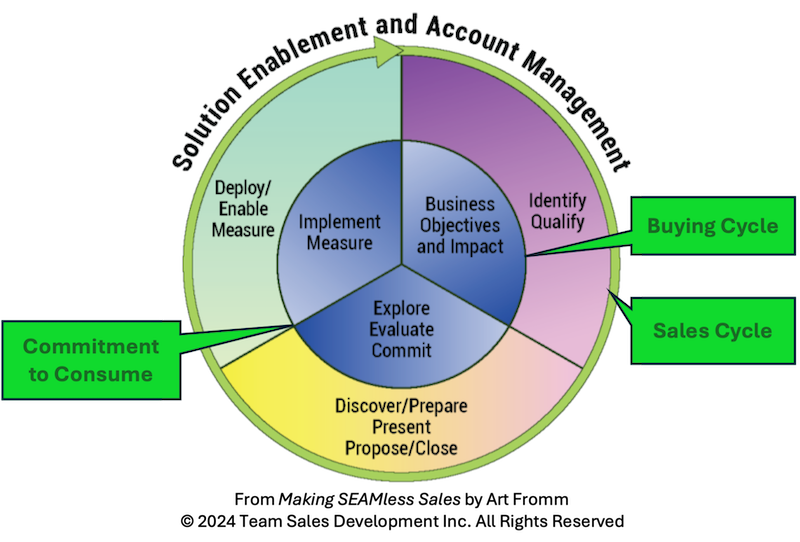In today’s competitive B2B landscape, the ability for sales and presales (technical sales) to work together seamlessly at the account and opportunity level is crucial and represents significant untapped potential. Despite this stark reality, these critical functions often operate in silos, inadvertently creating friction that impacts client success and top-line results. Some sales organizations have made strides to address the gap, but more often, sales teams are left to figure out how they can work together seamlessly on their own.
The Cost of Misalignment
Recent studies reveal a stark reality: When sales and presales aren’t aligned, the win rate is 38% less compared with deals where they are. Of significance to the SMM audience, this isn’t just a performance issue, it’s a strategic vulnerability at the core of the business – marketing, sales and the client-engagement team – that threatens an organization’s ability to qualify, develop, close and successfully deliver solutions for their clients effectively and efficiently. Thus, win rate and recurring revenue suffer dramatically.
Traditional organizational structures have historically separated sales and presales, inadvertently and unnecessarily exacerbating already challenging differences in personality style, personal goals and career goals. Each role has typically been relegated to fairly distinct and separate swim lanes: Account managers (AMs) focus on relationship building, commercials and opportunity closure, while sales engineers (SEs) support AMs by conducting demos that showcase the technical solution.
The SEAMless Sales Approach

The key to overcoming these challenges starts by being laser-focused on the buyer – a buyer-centric approach, with all client-facing roles (especially sales and presales) working together to support the overarching goal of solution enablement and lifetime account management operating like a flywheel, driving recurring revenue, renewals, consumption and potential expansion within the account. This approach, which we call the SEAMless Sales Approach, emphasizes the importance of a unified, client-focused strategy that aligns sales and presales teams toward a common goal.
Seamless sales is not just a structural or operational change – it’s a cultural transformation. Success depends on mutual respect between sales and presales teams, as well as a shared commitment to client outcomes. It also requires a willingness to dismantle traditional departmental silos and adopt a culture of continuous learning and adaptation.
Enabling Seamless Buyer Engagement
For seamless sales to become a reality, organizations must establish clear responsibilities. Rather than focus on progressing through the sales stages and tactically engaging various client-facing resources as needed, a mind shift is required to understand and cater to the way buyers want to be supported through the entire engagement, from “hello” to value attainment.
This begins by examining the sales process and buying process not as separate, linear tracks that hopefully culminate in a sale, but as a continuous, interdependent cycle with the buyer at the hub of the flywheel driving the entire process. Instead of a sale or push, the collective goal is to generate a buy or pull, resulting in a “committment to consume,” and then successfully enable the solution, resulting in increased client satisfaction, driving consumption, renewal and expansion.
Emerging technologies, particularly AI-driven sales enablement platforms and CRM apps that help salespeople sell and not just generate busy work, play a critical role in bridging communication gaps. These tools provide real-time insights, automate discovery processes and enable transparent information sharing between teams. As a result, sales and presales professionals can spend less time coordinating and more time focusing on customer value.
From a marketing perspective, this means offering systems that support automated “guided buyer browsing” while also being able to track and document all interactions and insights. The result is warmer leads with a complete understanding of the buyer’s exploration journey. This jump starts sales and frees up presales demo resources to focus on more highly qualified opportunities.
Specific to presales and sales, the focus needs to be identifying, managing and persuading two critical functions that drive the buying cycle: the business decision maker (BDM) and the technical decision maker (TDM). Typically, these functions are fulfilled by separate individual stakeholders. Sometimes, one or both functions may be fulfilled by a small team, while at other times, both functions may be covered by a single individual. The BDM focuses on strategic goals and overall business outcomes, while the TDM ensures that the technical requirements fulfill the BDM’s goals and desired outcomes and risks are comprehensively addressed.
Successful sales teams understand that these roles are interconnected with a healthy overlap and thus require a coordinated, collaborative and seamless approach that aligns the AM sales role with the BDM and the SE presales role with the TDM, respectively, including a healthy overlap. Account managers should focus on business close, confirming that business outcomes will be achieved and investments justified. Sales engineers should focus on the technical close, ensuring solutions meet technical requirements and support broader business objectives.
Practical Implementation Strategies
To support this, organizations should create intentional overlap and robust communication channels between sales and presales. This involves developing structured communication protocols to ensure clarity and accountability across teams. Joint planning and post-action review processes should be implemented to refine strategies and foster mutual understanding continually. Acknowledging each role’s unique contribution fosters respect and alignment toward common goals. For instance, regular joint planning sessions can be scheduled to align on account strategies, and post-action reviews can be conducted to learn from each other’s experiences and improve future collaboration.
Leadership plays a vital role in operationalizing seamless collaboration. This can be driven through cross-functional training programs that build empathy and shared knowledge. Implementing shared performance metrics helps reinforce accountability and alignment across functions. Regular collaborative sessions, such as joint planning or strategy meetings, further strengthen team cohesion and unity. Technology platforms that facilitate real-time information sharing and coordination across teams can make these practices sustainable and scalable.
Aligning compensation and metrics is equally essential. The Consensus 2025 Sales Engineering Compensation Report reveals that four out of five key performance indicators now directly relate to sales outcomes. This shift requires integrated performance metrics that incentivize collaboration, reinforcing a shared responsibility for closing deals and achieving client success.
The Tangible Benefits
Organizations that successfully integrate sales and presales functions see measurable improvements. Win rates increase by 15 to 38%, and sales cycles become shorter. Clients benefit from more consistent, high-quality experiences, which in turn drives increased recurring revenue potential. Perhaps most importantly, this integration enhances trust with key stakeholders – both internal and external – laying the groundwork for long-term partnerships. These tangible benefits not only improve the financial performance of the organization but also enhance its reputation and relationships with clients and partners.
In today’s environment of heightened customer expectations and increasingly complex sales cycles, a unified, client-focused approach is a strategic imperative. Organizations that build collaborative bridges between sales and presales will be better equipped to navigate the complexity, stand out in competitive markets, and deliver lasting value to clients.
Call to Action for Executives
Executives should begin by auditing collaboration gaps between sales and presales. From there, they can develop integrated training programs or engage external organizations to build cross-functional skills and empathy. Investing in collaborative technologies and establishing shared performance metrics are another key step. Above all, fostering a culture grounded in mutual respect and shared goals focused on client success will unlock the full potential of seamless sales execution.
The path to recurring revenue runs through seamless collaboration. By breaking down silos, establishing clear communication, and focusing relentlessly on client success from the first interaction, organizations can unlock new growth opportunities. The future of sales is one that is coordinated, client-centric and driven by teamwork.
For more information or to discuss workshops or a keynote for your organization, email info@teamsalesdevleopment.com.
Art Fromm is leading a webinar on his concept of SEAMless sales on July 10 at 3 p.m. Eastern. Learn more and register to attend or gain access to the recorded presentation.





